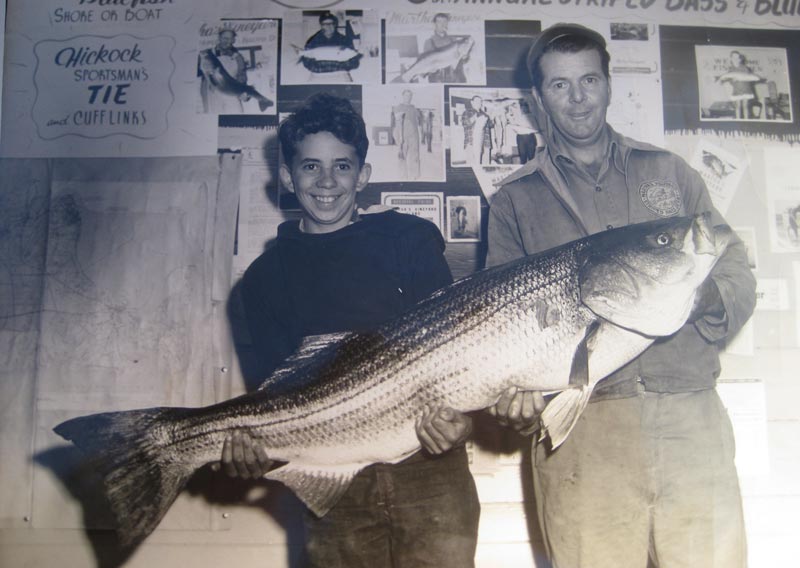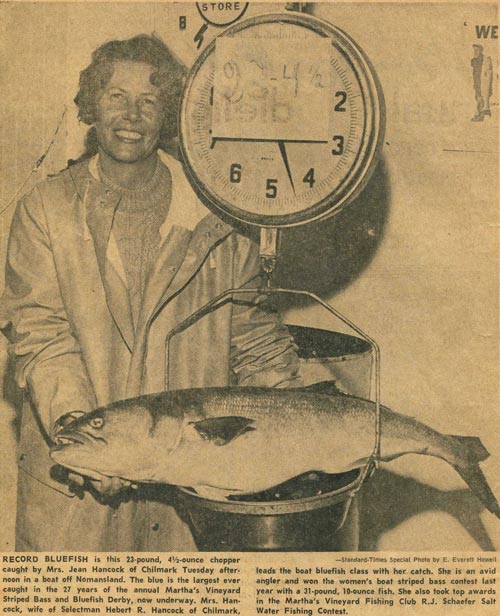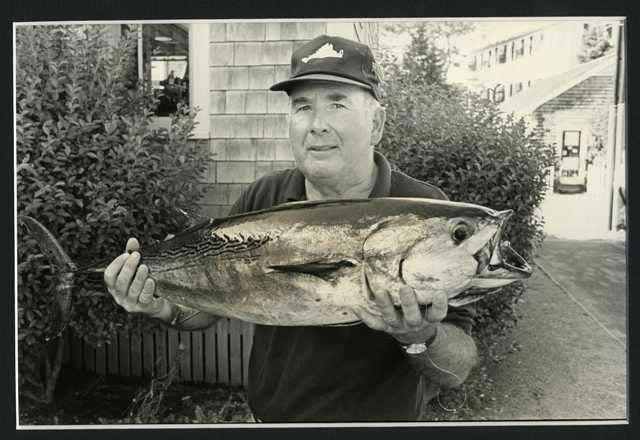If you were to go around the U.S. and ask 100 people what the “Derby” is, you most likely would have many answer that it is a horse race – in other words, the Kentucky Derby.
On the other hand, if you asked 100 fisherpersons from the Cape and islands what that terms signifies, you can be pretty sure that you would receive the same response from the vast majority. In this case, “the Derby” can mean only one thing – The Martha’s Vineyard Striped Bass and Bluefish Derby.
This year marks the 71st Derby, a fishing event that was first started as a promotion to increase business for a new ferry line to the Vineyard. A public relations man, Nat Sperber, is credited with coming up with the idea of the Derby.
With the assistance of the Martha’s Vineyard Rod and Gun Club, who agreed to sponsor the Derby, this event began in 1946 and has remained an incredibly important part of the fabric of Martha’s Vineyard lore and history.
The winning bass that first year was caught by Gordon Pittman from New York; it weighed 47-pounds even. The grand prize that year was $1,000 and a week’s stay at the Harborside Inn, but taken in terms of the current value of property on the island, it was the runner-up, Daniel Huntley of Buzzards Bay, who walked away with the most valuable award: a building lot in Gay Head.
Vineyard anglers have always been justifiably proud of their piscatorial skills, so it isn’t difficult to imagine that two off-islanders winning that first year most likely stuck in their craws. Although that first year included participants from 29 states among the 1,000 or so anglers entered, there certainly was a strong sense that the Derby was an island event – and, of course, nobody knew its waters better than a Vineyarder.
The second Derby saw island pride shine through as George Marshall of Vineyard Haven took the grand prize with a 45 pound, 13 ounce bass. This was the first of Mr. Marshall’s wins, the second coming two years later in 1949.

(Photo courtesy of Martha’s Vineyard Bass & Bluefish Derby)
In 1948, another category was added for bluefish, but as Steve Morris, a native islander, long time participant, member of the Derby Committee, and owner of Dick’s Bait & Tackle emphasized, “It’s always been about the biggest bass; the other species are fun, but everyone wants to catch the winning striper.”
It’s interesting to note that during the first four years when bluefish were eligible for prizes, the top fish ranged between four and six-pounds. After 1954, when a 9.55-pound fish was took first place, the winning blue has always been a double-digit fish. In fact, what followed that 11+-pound fish in 1955 is a good example of the historical wax and wane when it comes to bluefish, with every winner from 1968 to 1988 topping 17-pounds, including seven fish over 20-pounds during that time period.

(Photo courtesy of Martha’s Vineyard Bass & Bluefish Derby)
From 1981 to 1986, weakfish were introduced as an eligible species for consideration in the Derby due to their abundance, but in 1987 no tiderunners were weighed in and they were removed.
The Derby has often heeded the voices of conservation, including removing striped bass as an eligible species from 1985 to 1993 as most of the east coast was participating in a moratorium on catching stripers due to a collapse in the breeding stocks of this species.
When false albacore became a popular species, the Derby reacted to the number of dead albies that were left at the weigh station, a result of their being considering inedible by most anglers and, therefore, of no real use to the Derby program that donated fish to islanders in need. Ultimately, the tournament committee elected to limit the number of albies that an angler can weigh in during the entire Derby to three fish, as well as eliminating them from daily prize consideration.

(Photo courtesy of Martha’s Vineyard Bass & Bluefish Derby)
In addition, the Derby maintains a minimum length requirement for each species to be considered eligible for entry. In the case of stripers, the minimum, 32-inches, is actually higher than the state of Massachusetts minimum, which is 28-inches. The minimums for the other species are 21-inches for bonito; 22-inches for bluefish; and 25-inches for false albacore or little tunny.
Along with the decision to exclude striped bass from the Derby, 1985 also saw the introduction of boat and shore categories for each species. Over the years, there have been divisions added for flyrodders, seniors, juniors, mini-juniors, and ladies, as well as grand slam, team, and “top rod” competitions.
While the angler who caught the largest striper was considered the grand prize winner in the Derby from its origins until 1984, with bass eliminated from consideration, the top award was determined by luck of the draw among the other remaining species. Finally, in 2002, there were two grand prizes awarded, again by luck of the draw, from among the four anglers who caught the largest bass, bluefish, albie, and bonito from boat and shore.
Over the years, the Derby Committee has been open to any and all suggestions about how to make the event better. That has been the case no matter who was in charge of the Derby, with the Rod & Gun Club ceding control to the Martha’s Vineyard Chamber of Commerce in 1951. Finally, in 1986, the Derby went from an event run by a non-formal committee type organization under the Chamber of Commerce to a formal non-profit that has donated over $64,000 in scholarships to island high school graduates – while still upholding the Derby traditions of camaraderie and competition.
For more information on the Martha’s Vineyard Bass & Bluefish Derby, please visit MV Derby.com















